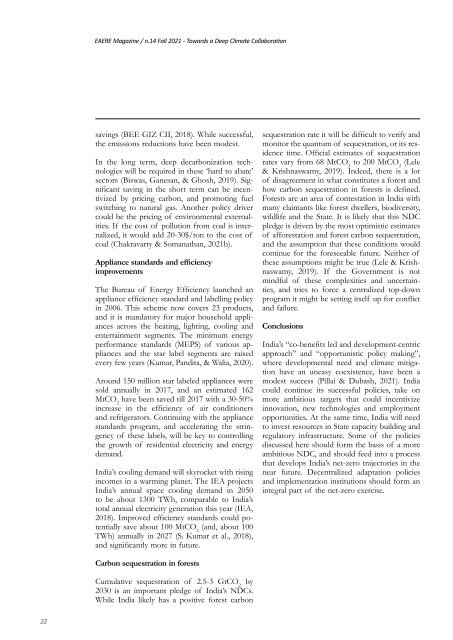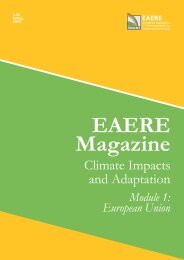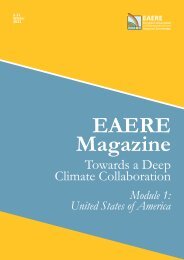EAERE Magazine - N.14 Fall 2021
Create successful ePaper yourself
Turn your PDF publications into a flip-book with our unique Google optimized e-Paper software.
<strong>EAERE</strong> <strong>Magazine</strong> / n.14 <strong>Fall</strong> <strong>2021</strong> - Towards a Deep Climate Collaboration<br />
savings (BEE GIZ CII, 2018). While successful,<br />
the emissions reductions have been modest.<br />
In the long term, deep decarbonization technologies<br />
will be required in these ‘hard to abate’<br />
sectors (Biswas, Ganesan, & Ghosh, 2019). Significant<br />
saving in the short term can be incentivized<br />
by pricing carbon, and promoting fuel<br />
switching to natural gas. Another policy driver<br />
could be the pricing of environmental externalities.<br />
If the cost of pollution from coal is internalized,<br />
it would add 20-30$/ton to the cost of<br />
coal (Chakravarty & Somanathan, <strong>2021</strong>b).<br />
Appliance standards and efficiency<br />
improvements<br />
The Bureau of Energy Efficiency launched an<br />
appliance efficiency standard and labelling policy<br />
in 2006. This scheme now covers 23 products,<br />
and it is mandatory for major household appliances<br />
across the heating, lighting, cooling and<br />
entertainment segments. The minimum energy<br />
performance standards (MEPS) of various appliances<br />
and the star label segments are raised<br />
every few years (Kumar, Pandita, & Walia, 2020).<br />
Around 150 million star labeled appliances were<br />
sold annually in 2017, and an estimated 162<br />
MtCO 2<br />
have been saved till 2017 with a 30-50%<br />
increase in the efficiency of air conditioners<br />
and refrigerators. Continuing with the appliance<br />
standards program, and accelerating the stringency<br />
of these labels, will be key to controlling<br />
the growth of residential electricity and energy<br />
demand.<br />
India’s cooling demand will skyrocket with rising<br />
incomes in a warming planet. The IEA projects<br />
India’s annual space cooling demand in 2050<br />
to be about 1300 TWh, comparable to India’s<br />
total annual electricity generation this year (IEA,<br />
2018). Improved efficiency standards could potentially<br />
save about 100 MtCO 2<br />
(and, about 100<br />
TWh) annually in 2027 (S. Kumar et al., 2018),<br />
and significantly more in future.<br />
sequestration rate it will be difficult to verify and<br />
monitor the quantum of sequestration, or its residence<br />
time. Official estimates of sequestration<br />
rates vary from 68 MtCO 2<br />
to 200 MtCO 2<br />
(Lele<br />
& Krishnaswamy, 2019). Indeed, there is a lot<br />
of disagreement in what constitutes a forest and<br />
how carbon sequestration in forests is defined.<br />
Forests are an area of contestation in India with<br />
many claimants like forest dwellers, biodiversity,<br />
wildlife and the State. It is likely that this NDC<br />
pledge is driven by the most optimistic estimates<br />
of afforestation and forest carbon sequestration,<br />
and the assumption that these conditions would<br />
continue for the foreseeable future. Neither of<br />
these assumptions might be true (Lele & Krishnaswamy,<br />
2019). If the Government is not<br />
mindful of these complexities and uncertainties,<br />
and tries to force a centralized top-down<br />
program it might be setting itself up for conflict<br />
and failure.<br />
Conclusions<br />
India’s “co-benefits led and development-centric<br />
approach” and “opportunistic policy making”,<br />
where developmental need and climate mitigation<br />
have an uneasy coexistence, have been a<br />
modest success (Pillai & Dubash, <strong>2021</strong>). India<br />
could continue its successful policies, take on<br />
more ambitious targets that could incentivize<br />
innovation, new technologies and employment<br />
opportunities. At the same time, India will need<br />
to invest resources in State capacity building and<br />
regulatory infrastructure. Some of the policies<br />
discussed here should form the basis of a more<br />
ambitious NDC, and should feed into a process<br />
that develops India’s net-zero trajectories in the<br />
near future. Decentralized adaptation policies<br />
and implementation institutions should form an<br />
integral part of the net-zero exercise.<br />
Carbon sequestration in forests<br />
Cumulative sequestration of 2.5-3 GtCO 2<br />
by<br />
2030 is an important pledge of India’s NDCs.<br />
While India likely has a positive forest carbon<br />
22













